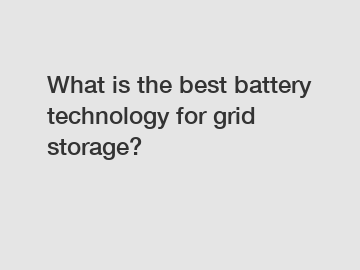What is the best battery technology for grid storage?
As the demand for renewable energy sources continues to rise, the need for effective grid storage solutions becomes increasingly important. One of the key components of grid storage systems is the battery technology used to store excess energy generated by renewable sources such as solar and wind power. But with so many different battery technologies available, which one is the best for grid storage?
One of the most popular and widely used battery technologies for grid storage is lithium-ion batteries. These batteries are commonly used in consumer electronics and electric vehicles and have been adapted for use in grid storage systems due to their high energy density, long cycle life, and relatively low cost. However, there are some drawbacks to this technology, including the potential for thermal runaway and safety concerns.
Another battery technology that is gaining attention for grid storage applications is flow batteries. Flow batteries use liquid electrolytes stored in external tanks, which allows for the separation of power and energy capacity. This design is particularly well-suited for grid storage applications where long-duration energy storage is required. Flow batteries also have a longer cycle life compared to lithium-ion batteries, making them a more cost-effective option in the long run.

One of the newer battery technologies that is starting to make a name for itself in the grid storage space is solid-state batteries. These batteries use a solid electrolyte instead of a liquid or gel electrolyte, which eliminates the risk of leakage and increases the safety of the battery. Solid-state batteries also have the potential for higher energy density and faster charging rates compared to traditional lithium-ion batteries.
In addition to these three battery technologies, there are a number of other options available for grid storage, including lead-acid batteries, sodium-ion batteries, and zinc-air batteries. Each of these technologies has its own unique benefits and drawbacks, making it important for grid operators to carefully consider their specific needs and requirements when choosing a battery technology for their system.
Ultimately, the best battery technology for grid storage will depend on a variety of factors, including cost, performance, safety, and longevity. It is important for grid operators to work closely with battery manufacturers and energy storage experts to determine the best technology for their specific application.
When it comes to grid storage, reliability is key. Grid operators need to be able to rely on their energy storage systems to provide a stable and consistent source of power, especially as more renewable energy sources are integrated into the grid. Choosing the right battery technology is essential to ensuring that the grid remains stable and reliable in the face of fluctuating energy demand and supply.
In conclusion, there is no one-size-fits-all solution when it comes to choosing the best battery technology for grid storage. Each technology has its own strengths and weaknesses, and the best choice will depend on the specific needs of the grid operator. By working closely with battery manufacturers and energy storage experts, grid operators can make an informed decision that will ensure the long-term reliability and stability of their grid storage system.
If you are looking for more details, kindly visit sunplus, String inverter for industrial solar applications, Maximum power point tracking three phase string inverter.



